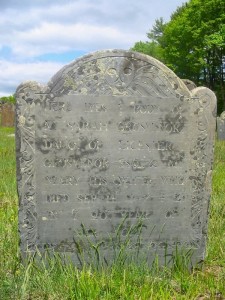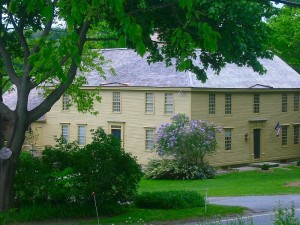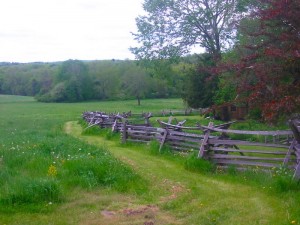How can we imagine the landscapes and material worlds of colonial Pomfret residents? No documents or visuals survive which capture the extent to which a particular tract or valley was cleared for pasture or kept in woodland. Deeds and probate inventories rarely allow us to estimate the size or siting of a particular house at a specific historical moment. But as humans we have a powerful desire to feel that we are “there.” The photographs and images on this page offer partial fulfillment.
The Yellow House
This elegant colonial-era house, much enlarged since the 1740s, was in the Grosvenor family in the eighteenth century. Our best guess is that it was the homestead of Sarah’s father, Leicester Grosvenor, militia Captain, leading town citizen, and justice of the peace. Thus we can imagine Sarah growing up here, sometimes accompanying her grandmother, Esther, on the walk down the pastures below the house and up the hill to the church at the town center (see next Image).
Source: Jessica Linker, photographed Summer, 2007.
The Fence
This is a summer scene today below the Grosvenor house. To walk to the town center, roughly two miles away, one would head down the gentle incline, angle leftward, and head up the steep hill to reach the ridge where the First Congregational Church was (and is) located.
Source: Jessica Linker, photographed Summer, 2007.
Sarah’s Grave
Today, the Old Burying Ground in Pomfret is well-kept up and accessible off Route 169, just south of Pomfret center. Since both the Grosvenors and Sessions were prominent families in the colonial era, it is not surprising that the family rows of gravestones are not far from each other. Here is the stone erected for Sarah Grosvenor after her death at age 19 from complications and infection stemming from the manual abortion performed by local physician John Hallowell. See if you can read the engraved writing!
Source: Jessica Linker, photographed Summer, 2007.
Amasa’s Grave
Amasa Sessions lived to the ripe age of 84. The flag appears due to the care that local members of veterans organizations take to at least annually place flags at the stones of veterans. How much of the gravestone writing can you read? We believe that both Sarah’s and Amasa’s (and most of the 18th-century stones in this cemetery) were engraved by _________ of ___, Rhode Island.
Source: Jessica Linker, photographed Summer, 2007.
Page Created: May 18, 2007
Last Modified: January 1, 2009

